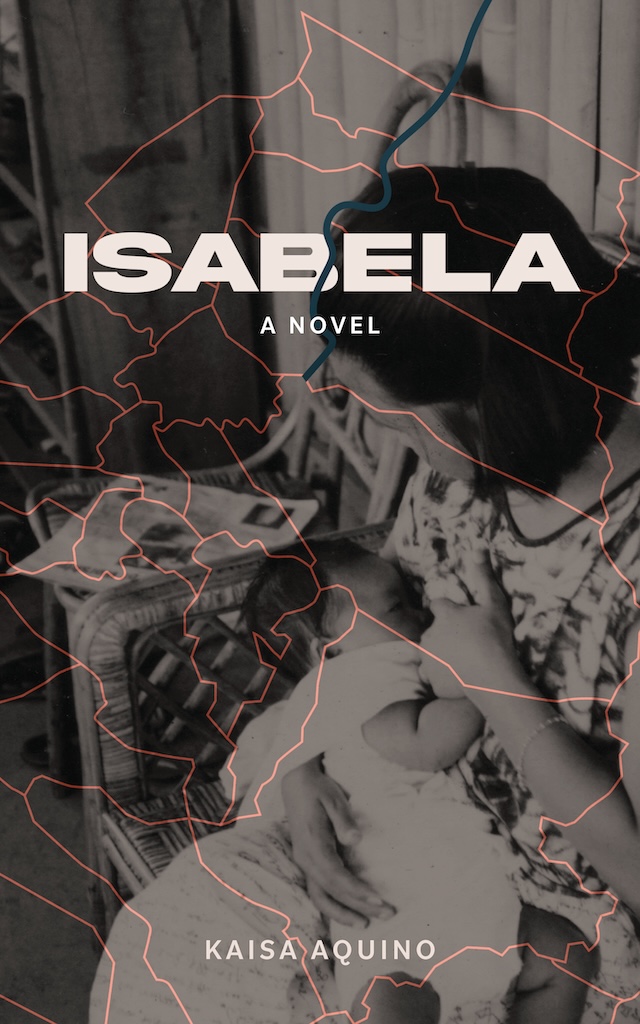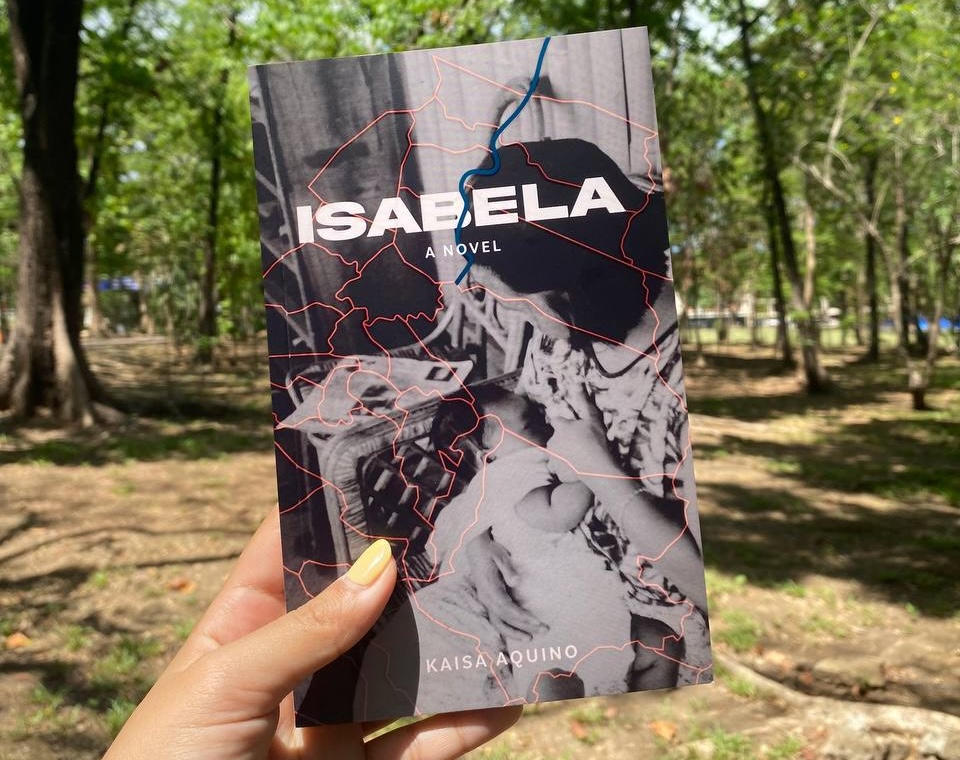Chapter after chapter, “Isabela,” Kaisa Aquino’s debut novel, marvels, surprises, experiments, and cuts no corners. It knows very well that it is a work past the parameters of fiction. Says author and professor Ruth Jordana Pison in her brief foreword, the novel “is a welcome addition to works on resistance or resistance literature in the Philippines,” which began to grow in publication following the toppling of the Marcos regime in 1986, and aptly so: one that offers rare illumination on the often misunderstood, unjustly vilified movement growing steadily in the mountains.
On the cover, a lovely work by Tanya Mallillin, is a monochromatic image of a mother breastfeeding her newborn, adorned with a map of Isabela. It’s a fitting visual rendering, precisely because the book tracks the lives of women—Ka Julia, Isang, Issey, Ka Abel, Sierra, Helen, Karina, May, Vida, Sabel, Belay, Celine, Belle, and Patis—who for a host of reasons have remained in, left, and returned to the land. Framed this way, the land, with its forest of history, with “all its idyllic goings-on,” auguries, and pockets of rest and relief, then intervenes materially, actively in the life of each character.
Chapter after chapter, “Isabela,” Kaisa Aquino’s debut novel, marvels, surprises, experiments, and cuts no corners.
Lé Baltar
And in the novel, Isabela’s history of resistance is not merely rendered as plot; it is its very life and in many ways the author’s. In fact, Aquino’s given name is a lexical blend of Cagayan and Isabela—a kilometer zero of sorts that steers her back to a place that has shaped, if not eroded, many inner lives, underground or otherwise, to stories that are “always [hers] to tell,” from the atrocities under martial rule to the Dy political dynasty in Isabela, to the coal mining that ravaged the province, and to the triumphs and lapses of the movement.
“Walang pinipiling lugar ang digma, Ka Julia,” declares a line in the prologue, which sees the female revolutionary, shot and separated from her comrades, wrestling with death and recalling “for a quarter of a heartbeat” her many, enduring selves, and thus thrusts the reader into the author’s expansive, overtly political vision. We are told: “You are these women, at one point, in the past, somewhere in the future. In another life.”

Much like the “shrubs where the bulbous bouquets of petals grow” and the purple hydrangeas that lie deep in the Sierra Madre, Aquino’s language is at once lush, profound, and intimate, allowing the reader to access as though in close contact the genesis of the wounds troubling her torrent of characters.
In a poignant encounter, for instance, Sierra, a young cadre whose “father was murdered by the military, shot dead and knifed through the guts, slashed from his abdomen to his side,” meets in the forest, on her birthday, her long-lost and only friend Karina, now unfortunately on the side of the military, the enemy, who gifts her a bundle of patupat—“sweet, sticky rice cooked in muscovado, wrapped in leaves, and steamed together”—they used to share. “It starts with a hiccup at first, and then Sierra starts to cry. Big, hot tears roll down her cheeks, choking out like a sob. If it wasn’t for what she is now and what Karina has become, she would’ve run after her friend,” it reads. It’s sequences such as this that point to an integral facet of the armed struggle, that its commitment to social justice and national liberation is, of course, complex, rife with necessary, unsung sacrifices, shaped by unforgiving circumstances.
The author in another section writes, “Perhaps she was still thinking about someone, the one who had left her for the hills, Balong, who had taken the midnight bus and had never looked back but Issey could not yet open her heart again that way for fear of love outrunning her.” Elsewhere are moments of tenderness, like a young queer couple sharing a shower, or a teenage girl observing a quiet hour with her father “as slow songs played in his small, battery-powered radio, a sweating pitcher of cool, buko juice on the table between [them],” or a rebel gently tending to a child that isn’t hers.
The reader may also find pleasure in the meandering nature of the narrative—“meandering” in ways that are exciting and sheer fun, as Aquino toys with names (mostly anagrams of the book’s title), of characters who may or may not be the same characters in previous or succeeding sections, just as she migrates between languages, between points of view, between time periods, between the city and countryside, engendering a terrific voice and musicality that’s often hard to attain when a writer wields it solely for effect, for literary pyrotechnics. In many ways, “Isabela” is an experiment as much as it is a demonstration of disciplined prose.
Oftentimes, historical resistance is viewed in gargantuan terms, but here, the author draws focus shrewdly to its shrapnels, the grief that lingers.
Lé Baltar
Particularly fascinating, too, is how the author seeds her English with Ilocano, a common language in Isabela, not to, dare I say it, “decolonize” the language of the empire, the weapon of the Filipino novelist writing in English, to the extent of rendering it “native” (if anything, it’s an admission of the limits of that very weapon), although, of course, there is the Philippine English, but simply to locate the beating heart of the novel and its specific arguments about history as well as state and colonial violence.
In her generous blurb for the book, the eminent writer Marjorie Evasco says that “the novel offers what could be a shared women’s radical point of view.” That description perfectly sums up what Aquino has achieved, in style as in thought, in about 200 pages, across five years of working towards its completion—a labor of radical love, as one might add. She demonstrates with conviction a story of various states of departure and ache but also of unbridled love and hope. Oftentimes, historical resistance is viewed in gargantuan terms, but here, the author draws focus shrewdly to its shrapnels, the grief that lingers. Characters, whether named or unnamed, lead transient lives, always in constant movement, packing for a journey that may well be long and winding, and perhaps promises no return. It’s not easy to barrel through this world, but they keep going. Because, as one of the women imparts, “That’s how it goes.” Kasdiyay latta.
Like many Filipino novels we’ve come to admire, or perhaps revere sweepingly, “Isabela” is sui generis, not only because it speaks of “three decades of the continuing people’s war,” a mapping that is distinctly Filipino, but how it articulates it through vantage points of women: mother, daughter, wife, sister, lover, friend, teacher, comrade, or otherwise. Aquino’s stroke of genius culminates in a heartbreaking yet hopeful juncture, where Ka Julia, despite everything, strengthens her resolve of “going home,” and this is where the author stakes a clear, unflinching line: that indeed a woman’s place is in the struggle that’s still growing, still rustling.
Few writers can handle what Aquino lays out here for us. It’s rare to come across revolutionary life gently, truthfully rendered on the page, a depiction that counters, if not pulverizes, the ridiculous narratives perpetually peddled by state spin doctors, especially under another Marcos regime. How astonishing, how humane, how singular, this debut.
Kaisa Aquino’s “Isabela” is available at the Ateneo de Manila University Press.



